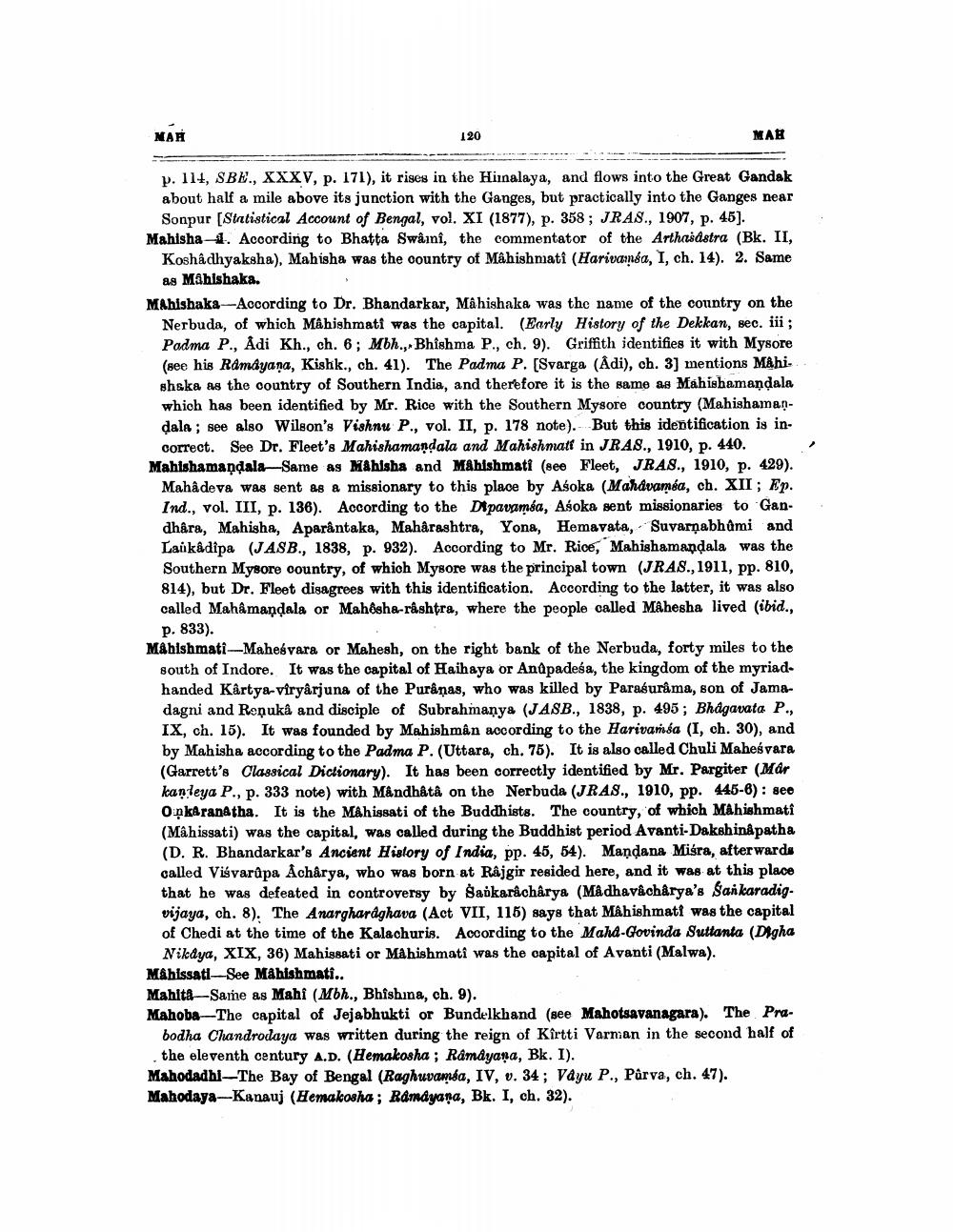________________
NAH
120
MAR
p. 114, SBE., XXXV, p. 171), it rises in the Hiinalaya, and flows into the Great Gandak about half a mile above its junction with the Ganges, but practically into the Ganges near
Sonpur [Statistical Account of Bengal, vol. XI (1877), p. 358; JRAS., 1907, p. 45). Mahisha-1. According to Bhatta Swâini, the commentator of the Arthasastra (Bk. II,
Koshâdhyaksha), Mahisha was the country of Mâhishmati (Harivainéa, I, ch. 14). 2. Same
as Mahishaka. MAhishaka--According to Dr. Bhandarkar, Mâhishaka was the name of the country on the
Nerbuda, of which Mahishmati was the capital. (Early History of the Dekkan, sec. iii ; Padma P., Adi Kh., ch. 6; Mbh. Bhishma P., ch. 9). Griffith identifies it with Mysore (gee his Ramayana, Kishk., ch. 41). The Padma P. (Svarga (Adi), ch. 3] mentions M&hi. shska as the country of Southern India, and therefore it is the same as Mahishamandala which has been identified by Mr. Rice with the Southern Mysore country (Mahishamandala : see also Wilson's Vishnu P., vol. II, p. 178 note). But this identification is incorrect. See Dr. Fleet's Mahishamandala and Mahishmati in JRAS., 1910, p. 440. Mahishamandala-Same as Mahisha and Mahishmati (see Fleet, JRAS., 1910, p. 429). Mahadeva was sent as a missionary to this place by Asoka (Mahavamsa, ch. XII; Ep. Ind., vol. III, p. 136). According to the Dipavamsa, Asoka gent missionaries to Gan. dhâra, Mahisha, Aparantaka, Maharashtra, Yona, Hemavata, Suvarnabhumi and Laukadipa (JASB., 1838, p. 932). According to Mr. Rice, Mahishamandala was the Southern Mysore country, of which Mysore was the principal town (JRA8., 1911, pp. 810, 814), but Dr. Fleet disagrees with this identification. According to the latter, it was also called Mahamandala or Mahsha-rashtra, where the people called Mahesha lived (ibid.,
p. 833). MAhishmati-Mahesvara or Mahesh, on the right bank of the Nerbuda, forty miles to the
south of Indore. It was the capital of Haihaya or Anđpadeśa, the kingdom of the myriadhanded Kártya-viryârjuna of the Puranas, who was killed by Parasurama, son of Jamadagni and Roņuka and disciple of Subrahmanya (JASB., 1838, p. 495; Bhagavata P., IX, ch. 15). It was founded by Mahishmân according to the Harivansa (I, ch. 30), and by Mahisha according to the Padma P. (Uttara, ch. 75). It is also called Chuli Mahesvara (Garrett's Classical Dictionary). It has been correctly identified by Mr. Pargiter (Már kanleya P., p. 333 note) with Måndhâtå on the Nerbuda (JRAS., 1910, pp. 445-6): see Onkaranatha. It is the MAhissati of the Buddhists. The country, of which Mahishmati (Mâhissati) was the capital, was called during the Buddhist period Avanti-Dakshinapatha (D. R. Bhandarkar's Ancient History of India, pp. 45, 54). Mandana Misra, afterwards called Visvarûpa Acharya, who was born at Râjgir resided here, and it was at this place that he was defeated in controversy by Saškaracharya (Må dhavicharya's Sankaradig. vijaya, ch. 8). The Anarghardghava (Act VII, 115) says that MÅhishmatt was the capital of Chedi at the time of the Kalachuris. According to the Maha-Govinda Sutlanta (Digha
Nikdya, XIX, 36) Mahissati or Mahishmatî was the capital of Avanti (Malwa). Måhissati-See Mahishmati.. Mahlta-Same as Mahi (Mbh., Bhishina, ch. 9). Mahoba-The capital of Jejabhukti or Bundelkhand (see Mahotsavanagara). The Pra
bodha Chandrodaya was written during the reign of Kirtti Varman in the second half of
the eleventh century A.D. (Hemakosha ; Ramayana, Bk. I). Mahodadhi--The Bay of Bengal (Raghuvamsa, IV, v. 34; Vayu P., Pârva, ch. 47). Mahodaya--Kanauj (Hemakosha; Ramayana, Bk. I, ch. 32).




